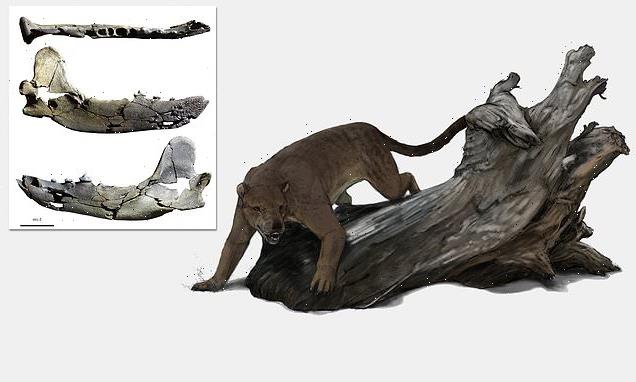Paleontologists have described a new species of large-sized amphicyonid carnivore from a fossilized mandible found in France.

Tartarocyon cazanavei. Image credit: Denny Navarra.
Amphicyonids (family Amphicyonidae) represent one of the most characteristic groups of predators in the ancient European faunas.
Often colloquially referred to as bear-dogs, these creatures resembled a cross between a bear and a large dog.
Amphicyonids first appeared during the Eocene epoch, some 36 million years ago.
Numerous amphicyonid species existed in Europe during the Early and Middle Miocene epoch, but they went extinct before the end of the Miocene, around 7.5 million years ago.
They were also ecologically diverse, ranged in body mass from 9 to 320 kg, and displayed typical mesocarnivorous, omnivorous, bone-crushing, and hypercarnivorous diets.
The newly-identified amphicyonid species had an estimated body mass of 200 kg.
Named Tartarocyon cazanavei, it lived in what is now France between 12.8 and 12 million years ago.
Its fossilized lower jaw was recovered from the marine deposits of Sallepisse in the Pyrénées-Atlantiques department, France.

“The jawbone was striking because of its teeth,” said Dr. Bastien Mennecart, a paleontologist at the Naturhistorisches Museum Basel.
“Unlike the familiar amphicyonid specimens, this animal had a unique fourth lower premolar.”
“This tooth is particularly important for determining species and genera.”

Holotype of Tartarocyon cazanavei from Sallespisse, France, in occlusal, lingual, and labial views. Scale bar – 5 cm. Image credit: Sole et al., doi: 10.7717/peerj.13457.
According to Dr. Mennecart and his colleagues, discoveries of fossilized terrestrial vertebrates that lived on the northern edge of the Pyrenees 13 to 11 million years ago are very rare.
“The discovery and description of Tartarocyon cazanavei’s lower jaw is even more significant,” they said.
“That is because it offers the opportunity to explore the development of European bear-dogs against the background of known environmental events at this time.”
Source: sci.news









